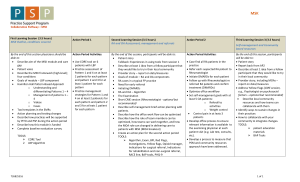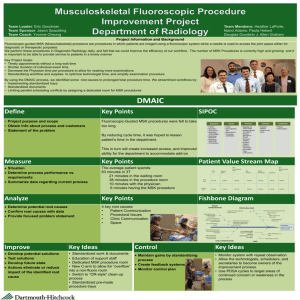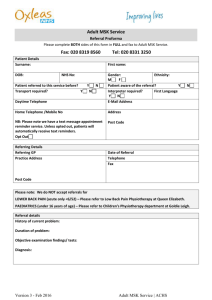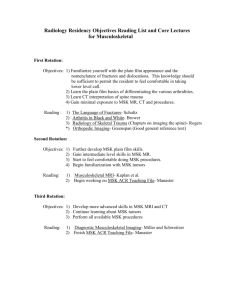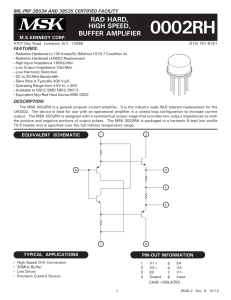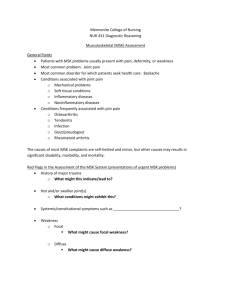MSK 20111107
advertisement
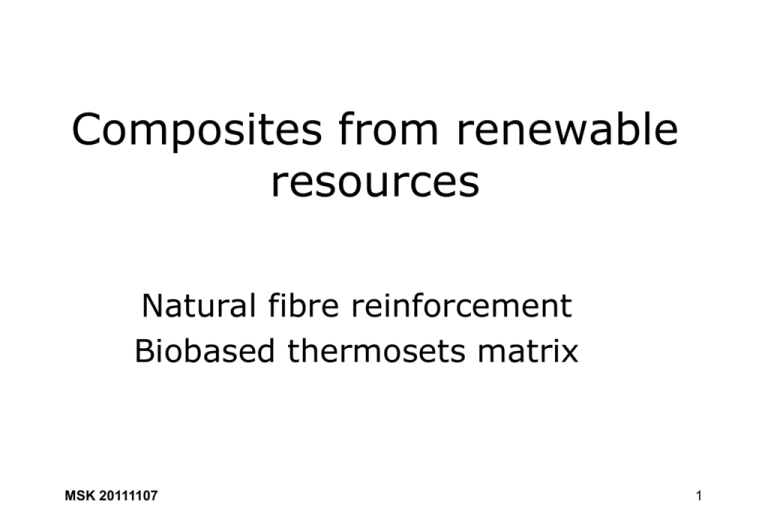
Composites from renewable resources Natural fibre reinforcement Biobased thermosets matrix MSK 20111107 1 Life cycle for fossil materials CO2 Combustion 0 to 10 years Plants Renewable resources Fuels Plastics 1 000 000 000 years MSK 20111107 Crude oil 2 Life cycle for biobased materials Combustion CO2 0 to 100 years 0 to 10 years Plants Renewable resources Fuels Plastics MSK 20111107 3 CARBON NEUTRAL • A material which has no impact on total atmospheric CO2 levels • The CO2 released due to incineration or decomposition is compensated by an equal amount of CO2 absorbed during photosynthesis for generating the biomass MSK 20111107 4 Historical development Conducting polymerers High-temp polymers NATURAL ORIGIN MATERIALS Wood Skin Fibers Straw-brick Paper 10 000 bC MSK 20111107 Polyesters PE Nylon Bakelit Natural rubber Fishbone glue Linoleum Celluloid Linseed oil paints 0 1800 1900 PP EpoxyPVC resins PS Biopolymers Carbon fibres Glass fibres SYNTHETIC MAN MADE MATERIALS 1950 2000 5 Ref: www.ars.usda.gov/is/pr/1998/980209.htm MSK 20111107 6 ENERGY CONSUMPTION DURING COMPOSITE PRODUCT LIFE-TIME 1% USE MANUFACTURE 99% MSK 20111107 7 Environmental impact of composites 1. 99 % of all product related energy is consumed during use, only 0.5 % during production 2. The environmental impact for composites is reduced by their durability, low weight, and energy efficient processing 3. Composites are by ¨defintion¨ environmentally friendly materials! MSK 20111107 8 Wood – a biobased composite 50 m 50 m Matrix: Lignin and extractives Reinforcement: Cellulose MSK 20111107 9 Wood – a anisotropic composite Y X Delamination in X direction MSK 20111107 No delamination in Y direction 10 Natural fibres – possible reinforcements for composites • Cellulose fibrous polymers • No new idea! • Textiles, ropes, canvas and paper have been made from natural fibres since centuries • Wool, flax and silk have a long tradition in textiles • Crude oil bases fibres replaced natural fibres • India and Brazil continued their use MSK 20111107 DDR’s Trabant contained natural fibres 11 Why natural fibers? Renewable Abundant Cheap Light weight Biodegradable Non-abrasive to processing equipment • CO2 neutral when incinerated • • • • • • MSK 20111107 • Flexible and though • Can be incinerated with energy recovery • Good mechanical stiffness • Good acoustic and thermal insulating properties 12 In nature occurring fibers: Plant fibers • Flax • Hemp • Kenaf • Jute • Ramie • Sisal • Banana • Coconut MSK 20111107 Animal fibers • Chicken feathers • Hair 1000 plants can be used for manufacturing industrially usable fibers….. 13 Use of natural fibres in composites in the German automotive production Market study by nova-Institut, Germany 20000 45 000 tons of plant fibre NFCs 36 000 tons of wood fibre NFCs 79 000 tons of cotton fibre NFCs 17200 18000 18000 15100 16000 12200 Quantity (t) 14000 Totally 160 000 tons composites of which 88 000 tons natural fibres 12000 9600 10000 8000 6000 4000 4000 About 16 kg natural fibres used per car in Germany Plant fibre market volume 15 million euro in automotive 65 % thermoplastic and 35 % thermoset matrices MSK 20111107 2000 0 1996 1999 2000 2001 2002 2003 Total 4000 9600 12200 15100 17200 18000 Hemp 0 300 1200 1600 2200 2300 Exotic (Jute, Kenaf, etc.) 2000 2300 2000 5000 6000 6300 Flax 2000 7000 9000 8500 9000 9400 14 Use of natural fibres North America 2000 Car parts 8% Other 7% Industry 10% Totally 200 000 ton (7 % of reinforcement and filler market volumes) 700 000 ton 2005 MSK 20111107 Construction 75% 15 Fiber properties Fiber E-modulus (Gpa) Strength (Mpa) Strain (%) Length (mm) Diam. (m) Density (g/cm3) Glass 72 2000-3400 1.8-3.2 Cont. 10 2.56 Ramie 128 500-1000 1.2-4 60-250 10-80 1.4-1.5 Flax 45-100 600-1100 1.5-2.4 13-70 10-30 1.37 Sisal 19-32 490-760 2.2-2.9 1-8 10-40 1.45 Hemp 35 400 1.1-1.6 5-55 10-50 1.4-1.5 MSK 20111107 16 Production of plant fibers Fibre Price comp. to glass (%) Jute 18 Production (1000 t) 3600 E-glass 100 1200 Flax 130 800 Sisal 21 500 Banana 40 100 MSK 20111107 Data from 1993 17 Composition of different cellulose based natural fibers Cotton Jute Flax Ramie Sisal Cellulose 82.7 64.4 64.1 68.6 65.8 Hemicellulose 5.7 12.0 16.7 13.1 12.0 Pectin 5.7 0.2 1.8 1.9 0.8 Lignin - 11.8 2.0 0.6 9.9 Water sol. Subst. 1.0 1.1 3.9 5.5 1.2 Wax 0.6 0.5 1.5 0.3 0.3 Water 10.0 10.0 10.0 10.06 10.0 MSK 20111107 Ref.: Bledzki, Prog. Polym. Sci. 24 (1999) 221 18 Properties for natural fibres Mechanical properties: • Large variations among species, dependence on environment and geographical cultivation location, climate and age Chemical properties: • Inhomogeneous and large variations, hydrophilic Physical structure: • Complex and heterogeneous, different properties on different size levels Surface properties: Heterogeneous, hydrophilic, must be modified before processing MSK 20111107 • 19 The cellulose polymer MSK 20111107 20 OH up Cellulose OH down Cellobiose repeating unit (-Dglucose) The combination of -D-glucose make it possible to form long straight chains DP 9 000 – 15 000 MW = 10 000 – 150 000 5 - 7 m linear length in wood Hydrogen bonds MSK 20111107 21 Compatibilization by maleic anhydride modified polymers Maleated polymer O H HO H H H O H O HO O H O HO OH H OH H O HO OH H H O O HO O O HO O O O H H HO Maleated polymer HOOC O O H H H H H H H OH H beta-D-glucose beta-D-glucose MSK 20111107 22 Flax (Linum usitatissimum) A bast fibre MSK 20111107 23 Flax fibres can be made into non-wovens • 30 % lighter than same stiffness glass fiber • Traditionally used in textiles • Industrial use as insulating material, and in automotive composites MSK 20111107 24 World-wide cultivation area for flax fibres Total area: China: France: Belarus: Russia: the Netherlands: Belgium: Ukraine: Lithuania: MSK 20111107 386 000 ha 132 500 ha 66 000 ha 40 000 ha 30 000 ha 16 300 ha 14 500 ha 9 300 ha 5 000 ha Data from FAOSTAT 2000 25 Flax cultivation output kg/ha: Raw flax Rippled flax Seeds Long fiber Short fiber Total fiber kg/ha 7950 6150 750 1560 290 1850 local variation 5 860 – 10 510 4 560 – 8 480 570 – 985 1 310 – 1 930 200 – 420 1 510 – 2 360 Data from Belgium cultivation tests 2002 MSK 20111107 26 Flax - from plant to fabric A step-wise process: - harvesting - seed rippling - drying - retting - scutching - hackling - carding - drawing - spinning - weaving - fabric treatment Seed rippling – traditional method Field retting Carding Spinning Weaving MSK 20111107 27 Air-laid insulation Scutching Scutched fibre bundles Short fibre tow Flax fibre processing cycle Hackling MSK 20111107 Long fibre line yarn Spun yarns Carding Spinning 28 Biotechnical retting process Developed by Finflax Ltd, Finland Characteristics: • • • • • Bioreactor retting vessel Closed system with recirculation and regeneration of retting liquor Pectinase and hemicellulose enzymes Easy to control (pH, temperature, O2) 12 - 24 hours processing time Benefits: 1. 2. 3. 4. 5. Shorter retting time Better fibre yield Better fibre strength Environmentally friendly process Well-controlled and reproducible method 6. Efficient method 7. Reduction of processing costs MSK 20111107 Photo: FinFlax Ltd 29 SEM surface analysis of enzyme and field retted flax fibres Field retted fibre, 1000X Enzyme retted fibre, 1000X Technical fibre, 50 – 100 m MSK 20111107 30 Kenaf (Hibiscus cannabis) • Grows 4 m in 7 months • Packaging materials, paper, oil-absorbents MSK 20111107 31 Jute (Corchorus casularis) • Short, inelastic fibres • Carpet backing, sacks, wall coverings, floor coverings MSK 20111107 32 SISAL PLANTAGE Photo by Kristiina Oksman MSK 20111107 33 Wood fibre reinforced thermoplastics • Wood polymer composites (WPC) • Wood fibres are used as a filler or reinforcement • Compounding by extrusion • Processing as thermoplastics • 10 – 70 w-% fibre content • PP, PE, PS, ABS, recycled thermoplastics MSK 20111107 34 Palltruder® Production of wood plastic omposites K2004 Exhibition, Düsseldorf MSK 20111107 www.pallmannpulverizers.com 35 Extrusion line for wood polymer composite profiles K2004 Exhibition, Düsseldorf MSK 20111107 36 Construction materials • • • • • • • MSK 20111107 50 % growth in the US Easy maintenance Compared to impregnated wood less toxic Processed as wood A wood-like surface finish Can be colored with pigments ¨A plastic¨ surface feeling and out-look 37 Car parts from natural fibres • • • • • • MSK 20111107 Mainly non-structural components for interior Flax, hemp, kenaf Reinforcement in non-woven form or chopped short fibres Processing by compression moulding EU directive End-of-Life Vehicle (ELV) demands that 85 % of car weight must be recycled, 10 % can be incinerated and only 5 % can be land-filled Plant fibres are 30-40 % of lower weight than glass fibres 38 TEXFLAX European project Flax yarn Flax fabrics Flax fibre Flax cultivation MSK 20111107 Composite product Composite laminates 39 TEXFLAX Demonstrator prototypes Sandwich panel Bicycle helmet MSK 20111107 Vacuum infused lid Flower pot Water tank 40 Design and biocomposites OLD CONCEPTS – NO DESIGN! MSK 20111107 NEW CONCEPTS – WITH DESIGN! 41 Kareline Ltd, Finland Wood composite compounds Window frame by Allplast • Bleached softwood pulp + polypropylene • 50 wt-% fibre content • Injection molding and extrusion molding • Design aspects considered Electic guitar by Flaxwood MSK 20111107 www.kareline.fi 42 Necessary developments: • Fibre processing techniques into usable forms • Dust and microorganism in plants can be health hazards • Hydrophilicity of natural fibers causes water sensitivity (rotting and swelling) • Matrix incompatibility causes poor mechanical properties • Seasonal variability in plant properties • Better understanding about mechanical properties and structure • Temperature stability (processability and recycling) • Burning smell and odours while processing at high temperatures MSK 20111107 43 Natural fibre reinforcements The environmental impact of the natural fibre reinforcements must be evaluated, and all steps must be considered • Cultivation: pesticides, fertilizers, erosion, farming equipment,… • Processing: fibre extraction, spinning and weaving • Disposal: end-of-life treatment • During use: durability in the composite MSK 20111107 44

